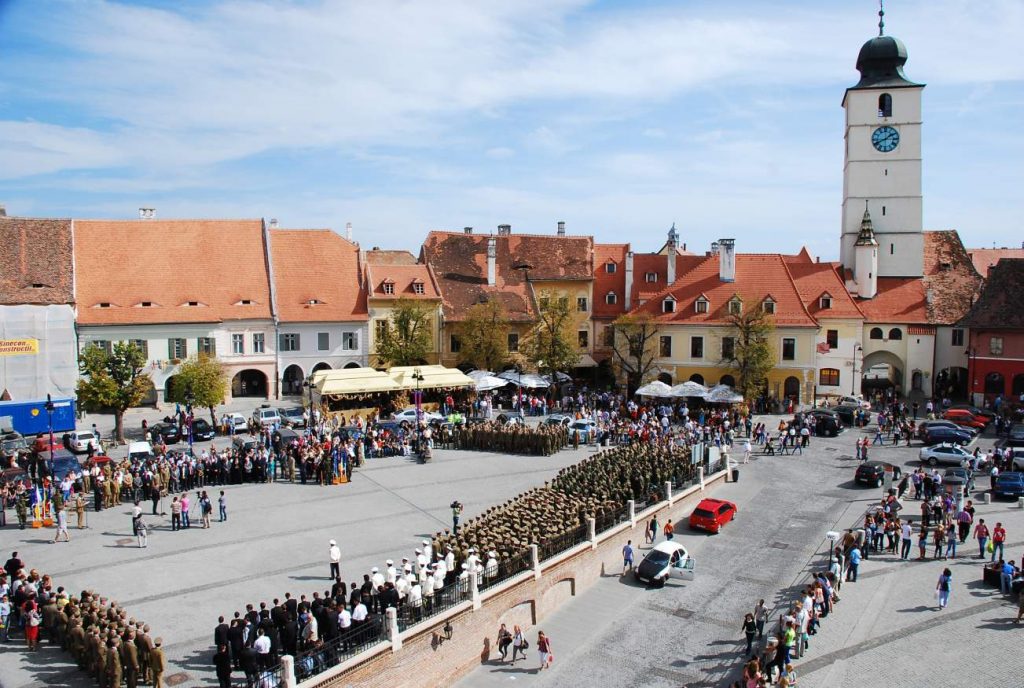Sibiu

During 2007, Sibiu co-organizes in partnership with Luxembourg The Cultural Capital of Europe. The slogan under which Sibiu is promoted and this event is “Sibiu, young man from 1191”. However, the first human settlements attested in the region occupied today by the city of Sibiu dates from the fourth century AD In that period, in the area where today is the Guşteriţa neighborhood, there was an important one Roman settlement.
And also from that century is preserved the “Donert of Biertan”, ale whose inscriptions in Latin come to attest once more the presence of a population of Romanesque origin in this region. In fact, this population is believed to be the interference that resulted after the Romanization of the Dacian population and after the retreat Romanians from Dacia.
Almost a millennium later, the first documents attesting to a settlement appear human resources on the territory of today’s Sibiu. On December 20, 1191, Pope Celestin al III issues an act by which the existence in Sibiu of a preposition a was confirmed Germans living in Transylvania. At the same time, this act also regulated the ecclesiastical organization of the Germanic settlers settled in Transylvania. The next act proving the presence of Germanic settlers in the region Sibiu dates a few decades later, when King Andrew II issued in 1224 a golden bubble through which German settlers enjoyed certain rights and privileges, thus placing themselves above the native population. The first forms of administrative organization of the Saxons are the seats, who are being certified for the first time once in 1302, so that in 1355 the province of Sibiu was attested, which at that time the weather counted seven seats. In fact, during this period Sibiu also received the title of civitas, in 1366 being mentioned for the first time in a document the name of Hermannstadt.
Today, the people of Sibiu boast the medieval side of their city. The medieval era of constituted for Hermannstadt a prolific period in all respects, both economically and administratively. Economically, in Hermannstadt the craftsmen who organize themselves are clearly highlighted, depending on the different one’s activities and trades, in guilds. The year 1376 finds in Hermannstadt 19 guilds, for to reach 40 in the eighteenth century. However, the Middle Ages was also a grinding period for Sibiu. Located on the border between the Kingdom of Hungary, May The late Habsburg Empire, and the Ottoman Empire, Sibiu played several roles, from administrative center of the region to the battlefield, it was set on fire in May many lines. The defeat of the Ottoman Empire by the Habsburgs in the twentieth century XVII, transformed Sibiu between 1692 and 1790 into the capital of the Principality Transylvania. In 1745, the first postal line was established between Sibiu and Vienna. She performed races between the two cities twice a month. In the first half of the 19th century, Sibiu received a new wave of settlers, they came from Austria. In parallel with the increase in the population of Germanic origin, Sibiu also becomes a center of the Romanians and of their struggle for freedom. Into the 18th century, the Diet of Transylvania and the Romanian National Party from Transylvania. The 19th century finds Sibiu in full economic development and demographic, the outskirts of the city far exceeding the defensive walls of the period medieval. In 1900 Sibiu had 26,000 inhabitants, of which 15,000 were Germans. The name changes from Hermannstadt to Sibiu in 1919. Sibiu was like that the third city in the Austro-Hungarian Empire in which electric lighting was introduced and the second in which the electric tram was introduced. In 1925 the population Sibiu had grown to 44,000 people, of which 23,000 were Germans. The situation would it changes drastically with the advent of communism, in 1945 beginning the deportation to the Soviet Union. However, his urban plans Ceausescu left the old town intact, Sibiu becoming in 1968 the county seat with the same name. On December 21, 1989, Sibiu was the second city in Romania that revolted against communism. In 2007, Sibiu was declared The Cultural Capital of Europe, next to Luxembourg.